Overview
1. On November 18 and the first half of November 19 rocket fire attacks into Israeli territory continued, although they were fewer than during the previous 24 hours. Nevertheless, the damage to people and property was greater. Two long-range rockets were fired at the Tel Aviv area, both intercepted by the Iron Dome aerial defense system. Hamasis responsible for most of the rocket fire, followed, with significantly fewer launchings, by the Palestinian Islamic Jihad(PIJ) and other small organizations.
2. During the past 24 hours the IDF has continued massive air strikes in the Gaza Strip. One hundred and thirty terrorist targets were attacked, among them underground launchers, rocket-launching squads, tunnels, terrorist bases, Hamas' communications infrastructure (Hamas' Al-Aqsa TV building), homes of terrorist operatives and the Hamas police force headquarters. The increase in the strikes also led to an increase in Palestinian casualties, among them non-involved civilians, including a Palestinian family in the northwestern Gaza Strip which was struck in error.
3. The focus of political attention is currently Cairo, where President Mohamed Morsi is leading attempts to find a mechanism to stop the fighting. Hamas and PIJ representatives have gone to Cairo as well, while behind the scenes, Morsi's effort receives support from American President Obama, as well as Turkey and Qatar (which support Hamas' position). The Hamas and PIJ representatives told the Egyptian and Arab media what their opening positions were for negotiations: no buffer zone in the Gaza Strip along the security fence (as allegedly demanded by Israel), permission to fish off the coast of the Gaza Strip, an end to the targeted killings of terrorist operatives, a refusal to commit to ending the military buildup in the Gaza Strip. A Hamas spokesman added that "lifting the [so-called] siege" and opening the crossings were also on the table for negotiations.
Rocket Fire into Israel
4. Massive, sustained rocket fire attacks on Israel continued throughout November 18, with 94 rocket hits identified during the past 24 hours (as of 1200 hours, November 19). While the amount of rocket fire was smaller than during the previous 24 hours (IDF Spokesman, November 18, 2012), it caused more casualties and far more property damage.
5. The most destructive rocket attacks were the following:
1) At 2300 hours on November 18, after three hours without an attack, a rocket fell in one of the villages in the Be'er Tuvia region of the northern Negev and caused extensive damage. There were no casualties.
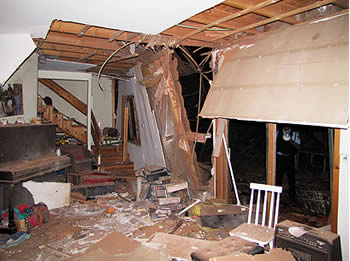
The damage done to the house in the Be'er Tuvia region (Spokesman for the local regional council, November 18, 2012).
2) On November 18 two long-range rockets were fired at the Tel Aviv area, one in the morning and the other in the evening. Both were intercepted and destroyed by the Iron Dome aerial defense system.
3) A rocket which hit the southern Israeli city of Ofaqim caused extensive damage to a home and a car. The four passengers, parents and their children, left the car when they heard the sirens; the car was damaged by flying rocket debris.
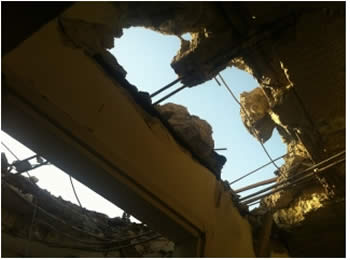
Damage to a home in Ofaqim (Sderot Media Center, November 17, 2012).
4) Two rocket hits in Ashqelon caused extensive damage to a home and several cars.
5) A rocket which hit near apartment buildings in Beersheba caused considerable damage to the buildings and nearby cars.
6) A home in Sderot was damaged by a rocket hit. The inhabitants were not there at the time.
6. On the morning of November 19, after a relatively quiet night, rocket fire was renewed. Several rockets hit the western Negev, and some targeted Ashqelon. As of noon more than 20 rocket hits had been identified. In Ashqelon a rocket hit close to a school and caused damage.
Terrorist Organizations Attempt to Attack the Tel Aviv Area
7. Six long-range rockets have been fired at the Tel Aviv area since the operation began. The first landed in Rishon Letzion (13 kilometers, or eight miles south of Tel Aviv) in the early afternoon of November 15. Two rockets were fired at Tel Aviv on November 18, one in the morning and one in the evening; both were intercepted by the Iron Dome. Fragments from one of the rockets hit a car in the city of Holon south of Tel Aviv and set it on fire. Hamas' military-terrorist wing claimed responsibility for the two rockets targeting Tel Aviv (Al-Aqsa TV, November 18, 2012).
8. The terrorist organizations in the Gaza Strip turned launching rockets at Tel Aviv into a symbol of an alleged Palestinian "victory." That was despite the small number of rockets fired (most of their long-range rockets were destroyed at the beginning of the operation), despite the fact that some of them were intercepted and destroyed, and despite the fact that routine daily life in the Tel Aviv area was almost unaffected.
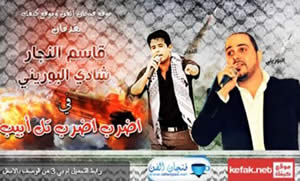
A new Palestinian song sung by Shadi al-Boureini and Qassem al-Najar, called "Strike a Blow on Tel Aviv" has enjoyed success on YouTube and appears on many Palestinian websites and Facebook pages. The lyrics are "We want to strike a blow on Tel Aviv. Don't let the Zionists sleep. We don't want a truce or a solution…"
Statistical Data
9. So far, more than 600 rocket hits have been identified in Israeli territory, of the more than 1000 rockets fired. An estimated 30% of the rockets fell in the Gaza Strip or into the sea. Less than 4% of the rockets hit populated areas. So far the Iron Dome has intercepted more than 300 rockets, that is, about half of the rockets fired into Israel.
Rockets Hits in Israeli Territory since the Beginning of 2011
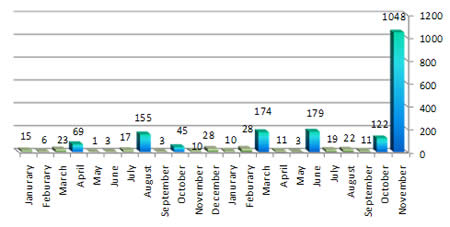
Note: The graph clearly illustrates the rounds of escalation and their increasing frequency during the six months until Operation Pillar of Defense. It includes 625 rocket hits identified during the operation, which still continues.
Daily Distribution of Rocket Hits in Israel's South since the Beginning of Operation Pillar of Defense
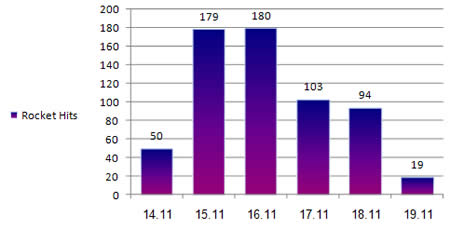
– The graph shows the decrease in rocket hits as of November 19, 1200 hours.
– So far 625 rocket hits have been identified in Israeli territory.
– Seven long-range rockets(of more than 40 kilometers, or 25 miles) either fell or were intercepted in the Tel Aviv area and one in the Jerusalem area.
Annual Distribution of Rocket Fire since the Hamas Takeover of the Gaza Strip

*Based on an estimated 625 rocket hits as of 1200 hours, November 19 (the number of launchings, in our assessment, is about three times greater than the number hits).
Claiming Responsibility for Rocket and Mortar Shell Fire
10. Hamas has claimed responsibility for most of the rocket fire, including the rockets fired at the Tel Aviv area: lagging behind is the PIJ. Other organizations have also made claims, such as the Popular Resistance Committees, the Popular Front for the Liberation of Palestine, the Democratic Front for the Liberation of Palestine, the Al-Aqsa Martyrs Brigade and various networks affiliated with the global jihad (Websites of the organizations).
11. On the afternoon of November 18 Hamas' military-terrorist wing issued an unfounded, fabricated claim of firing a self-produced long-range M75 rocket at Herzliya (about 11 kilometers, or 7 miles, northeast of Tel Aviv) (Izz al-Din al-Qassam Brigades website, November 18, 2012).
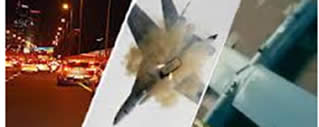
Alleged "achievements" never achieved: bombing Tel Aviv, downing an Israeli fighter plane and destroying an Israeli UAV (Izz al-Din al-Qassam Brigades website, November 17, 2012).
To the Full Document in PDF Format >>












